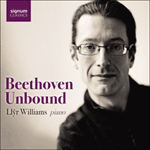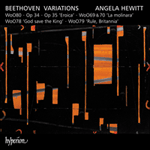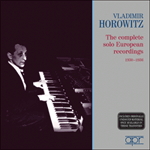Beethoven’s most overt pianistic homage to the Baroque, the 32 Variations on an original theme in C minor, WoO80, date from the end of 1806 (the year of the ‘Razumovsky’ quartets, the fourth symphony and the violin concerto) and were published the following year without dedication or opus number. The variations are an elaborate take on the traditional chaconne, a ceremonial triple-time dance over a ground bass that was popularized at the court of Louis XIV. (Bach’s monumental D minor violin ciaconna and Handel’s G major chaconne are famous examples, though it is doubtful that Beethoven would have known either.) Again, the music may have originated in the composer’s famous extemporizations. The stern eight-bar theme, with its emphasis on the second beat of the bar (a characteristic of the chaconne, played up by Beethoven), is underpinned by a chromatically falling
lamento bass. Most of the variations adhere more closely to the theme’s harmonic pattern than its melodic outline, and seem designed to showcase a wide range of keyboard techniques and textures—not least the
leggiermente staccato semiquavers, first in the right hand, then in the left, then in both simultaneously, in variations 1-3. Variations 7-9 explore more Romantic sonorities, while Nos 10 and 11 erupt in a torrent of demisemiquavers, a real test of the player’s virtuosity.
The poetic heart of the work lies in the five central major-keyed variations, beginning with No 12, closer in outline to the original theme than any of the previous variations. Opening the final, minor-keyed group of variations, No 17 (marked dolce) dissolves the theme in a soft, almost Schumannesque glow. The spirit of the Baroque is extravagantly reaffirmed in the sweeping flourishes of No 18, after which the variations veer between barnstorming extroversion (above all in the percussive hammering of Nos 26 and 27) and (say, in the limpid No 23 and the mysterious No 30) an echt-Beethovenian inwardness.
from notes by Richard Wigmore © 2018
L’hommage pianistique le plus manifeste de Beethoven à la musique baroque, les 32 Variations sur un thème original en ut mineur, WoO80, datent de la fin de l’année 1806 (l’année des quatuors «Razoumovski», de la quatrième symphonie et du concerto pour violon) et furent publiées l’année suivante sans dédicace ni numéro d’opus. Ces variations sont un point de vue élaboré sur la chaconne traditionnelle, une danse ternaire de cérémonie sur une basse obstinée qui fut vulgarisée à la cour de Louis XIV (la monumentale chaconne pour violon en ré mineur de Bach et la chaconne en sol majeur de Haendel en sont des exemples célèbres, mais il n’est pas certain que Beethoven les ait connues). Une fois encore, la musique émana peut-être des célèbres improvisations du compositeur. Le thème sévère de huit mesures, avec son accentuation sur le second temps de la mesure (caractéristique de la chaconne, sur laquelle Beethoven met l’accent), est étayé par une basse
lamento au chromatisme descendant. La plupart des variations adhèrent plus étroitement au schéma harmonique du thème qu’à son profil mélodique et semblent conçues pour servir de tremplin à un vaste éventail de techniques et de textures pianistiques—en particulier les doubles croches
leggiermente staccato, tout d’abord à la main droite, puis à la main gauche, puis aux deux mains simultanément, dans les variations 1 à 3. Les variations 7 à 9 explorent des sonorités plus romantiques, alors que les variations 10 et 11 éclatent dans un torrent de triples croches, véritable test de la virtuosité de l’instrumentiste.
Le cœur poétique de cette œuvre se situe dans les cinq variations centrales en majeur, commençant par la douzième, au profil plus proche du thème original que les variations précédentes. Ouvrant le dernier groupe de variations en mineur, la variation nº 17 (marquée dolce) fait fondre le thème dans un doux éclat presque schumannien. L’esprit de la musique baroque est réaffirmé à outrance dans les ornements abondants de la variation nº 18, après quoi les variations oscillent entre l’extraversion tonitruante (surtout dans le martèlement percussif de la 26ème et de la 27ème) et une intériorité echt-beethovenienne (par exemple, dans la limpide variation nº 23 et la mystérieuse variation nº 30).
extrait des notes rédigées par Richard Wigmore © 2018
Français: Marie-Stella Pâris
Beethovens offensichtlichste pianistische Hommage an die Musik des Barock sind die 32 Variationen über ein eigenes Thema in c-Moll, WoO 80, die gegen Ende des Jahres 1806 (in dem er auch die „Rasumowsky“-Quartette, die vierte Symphonie und das Violinkonzert komponiert hatte) entstanden und im folgenden Jahr ohne Widmung und ohne Opuszahl veröffentlicht wurden. In den Variationen setzt er sich in aufwendiger Weise mit der traditionellen Chaconne auseinander, ein zeremonieller Tanz im Dreiertakt über einem Ostinato-Bass, der am Hofe Ludwigs XIV. äußerst beliebt war und sich dann entsprechend ausbreitete. (Bachs monumentale Ciaconna d-Moll für Violine solo und Händels G-Dur-Chaconne sind berühmte Beispiele für das Genre, doch ist es fraglich, ob Beethoven sie gekannt hat.) Auch hier besteht die Möglichkeit, dass die Musik ihren Ursprung in den berühmten Improvisationen des Komponisten hatte. Das entschiedene achttaktige Thema, mit der Betonung jeweils auf dem zweiten Schlag (ein Charakteristikum der Chaconne, das Beethoven hier hervorstreicht), wird von einem chromatisch abfallenden Lamento-Bass begleitet. In den meisten Variationen wird das harmonische Gerüst des Themas strenger eingehalten als die melodischen Konturen; zudem sind sie offenbar darauf angelegt, ein breites Spektrum pianistischer Techniken und Texturen zur Geltung zu bringen—nicht zuletzt die mit
leggiermente bezeichneten Staccato-Sechzehntel, zuerst in der rechten Hand, dann in der linken und schließlich zusammen, in den Variationen 1-3. In Var. 7-9 werden romantischere Klangbilder erforscht, während in Var. 10 und 11 eine Flut von Zweiunddreißigsteln hervorbricht, womit die Virtuosität des Ausführenden auf eine harte Probe gestellt wird.
Das poetische Herzstück des Werks liegt in den fünf zentralen Dur-Variationen (beginnend mit Var. 12), welche dem Profil des Themas näher kommen als die vorangegangenen Variationen. Die letzte Variationengruppe, in Moll, beginnt mit Var. 17, die mit dolce bezeichnet ist und das Thema mit einem sanften, fast Schumann’schen Glühen auflöst. Der barocke Geist wird mit den ausladenden Gesten von Var. 18 aufwendig bestätigt, woraufhin die restlichen Variationen zwischen mitreißender Extravertiertheit (besonders in dem perkussiven Hämmern von Var. 26 und 27) und echt Beethoven’scher Innerlichkeit (wie etwa in der durchsichtigen Var. 23 und der geheimnisvollen Var. 30) wechseln.
aus dem Begleittext von Richard Wigmore © 2018
Deutsch: Viola Scheffel




 Beethoven: Beethoven Unbound
Beethoven: Beethoven Unbound Beethoven: Variations
Beethoven: Variations Vladimir Horowitz - The complete solo European recordings
Vladimir Horowitz - The complete solo European recordings
